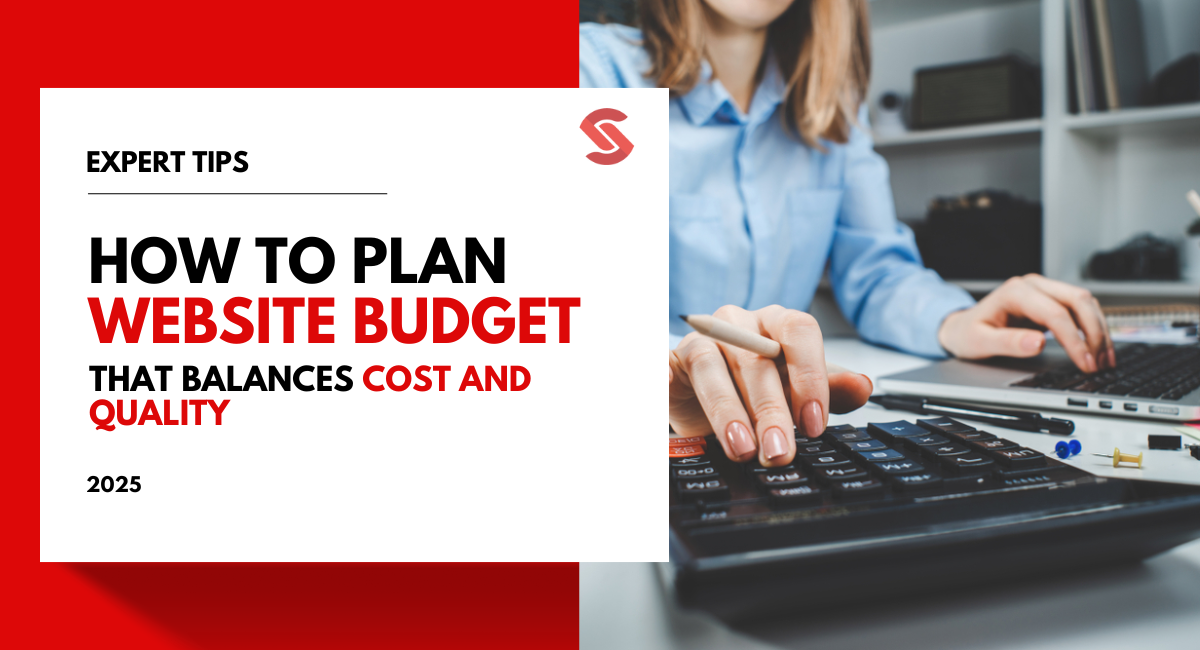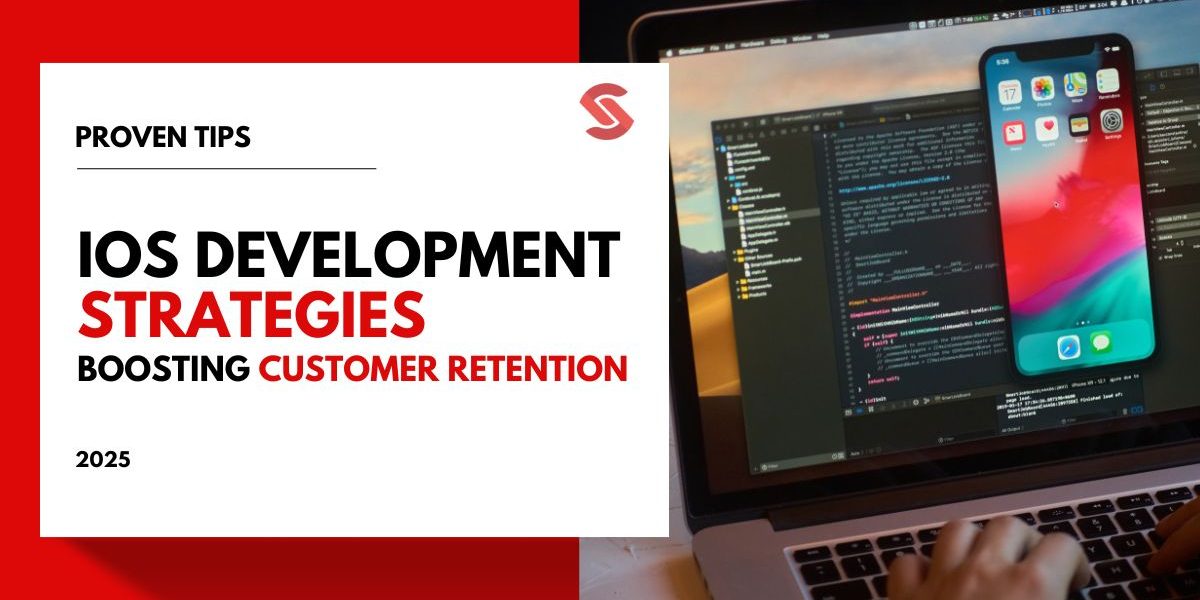Planning a website is like building a house, you want something beautiful, strong, and within your budget. Just as surprise phone bills can throw off your monthly expenses, web design projects can quickly become costly if you don’t plan your budget carefully.
As per one of Clutch’s reports 46% of small businesses spend between $10,000 and $50,000 on website development, showing how significant this investment can be. The real challenge is creating a website that looks great, works well, and doesn’t break the bank.
This blog will help you understand how to plan your website budget smartly. We will discuss Key, elements, factors, and practical tips to ensure you get a high-quality website that meets your needs without draining your resources or compromising your vision.
Why Budgeting for Website Development is Crucial
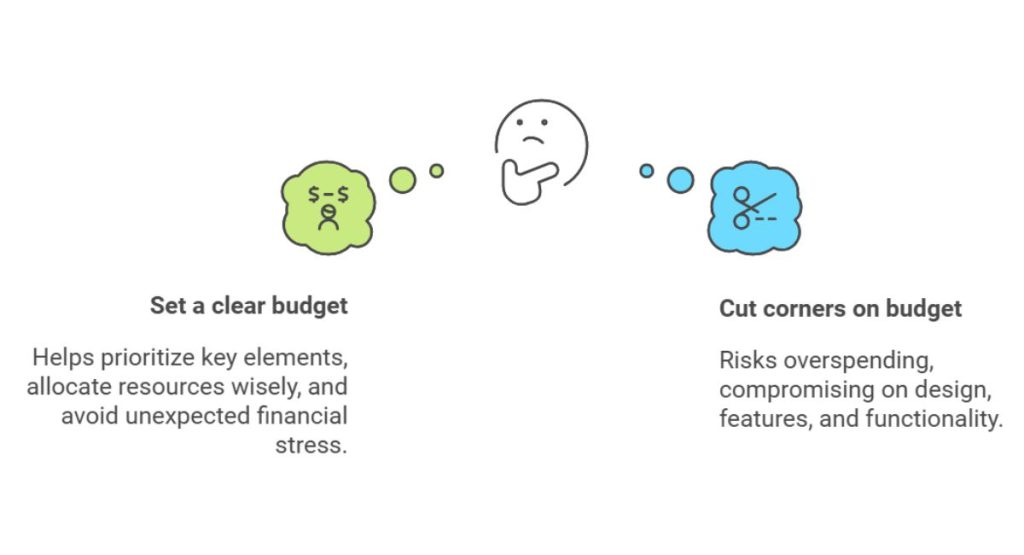
A clear budget is the backbone of any successful website development project. Without a well-planned financial roadmap, businesses risk overspending, cutting corners, or getting stuck midway through their digital creation.
Proper budgeting helps teams make smart choices about design, features, and functionality.
It allows companies to prioritize key elements, allocate resources wisely, and avoid unexpected financial stress.
Your budget becomes a strategic tool that guides every decision, from selecting the right developer to choosing the most critical website features. By setting a realistic budget upfront, you create a clear path to building a website that meets your goals without draining your resources.
Key Components of a Website Development Budget
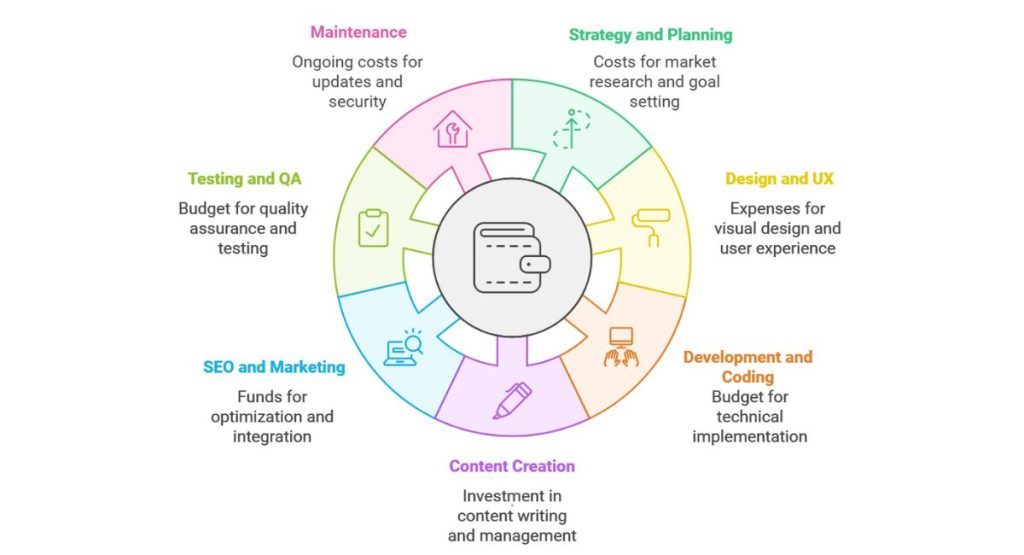
Building a website involves multiple layers of expenses. Your budget needs to cover visual design, coding, content creation, hosting, testing, and maintenance. Each component plays a vital role in creating a professional website.
Understanding these key areas helps you distribute your funds wisely, ensuring you invest in the right places to create a robust digital platform that represents your brand effectively. By breaking down these key elements, you can make informed decisions that balance quality and cost throughout your website development project.
1. Strategy and Planning Costs
Successful website development starts with a solid strategy that requires careful planning and investment. This initial phase involves in-depth market research, understanding your target audience, and analyzing competitors to create a clear roadmap.
Businesses typically spend time and resources identifying website goals, defining user needs, and mapping out a comprehensive digital strategy. These strategic planning sessions help prevent costly mistakes later by providing a clear direction for design and development.
Investing in thorough planning ensures your website aligns perfectly with your business objectives and user expectations.
2. Design and User Experience (UX) Costs
Developing an effective website requires strategic investment in professional UI/UX services that balance visual design with user functionality. Your design budget covers critical visual elements like color schemes, typography, and layout that speak directly to your target audience.
These design choices extend beyond surface-level beauty, focusing on creating an intuitive user journey that guides visitors seamlessly through your website. A well-designed site builds credibility, enhances user engagement, and supports your business goals by making navigation simple and meaningful.
3. Development and Coding Costs
Creating a powerful website requires skilled development and advanced coding techniques. Your development budget covers critical technical aspects that transform your design into a fully functional online platform.
The core expenses typically include:
- Ensuring responsive design across different devices and platforms
- Backend programming to handle data and server-side logic
- Frontend development for user-facing interactions
- Database integration and management
- Custom feature implementation
These elements ensure your website tells a clear, compelling story that resonates with your audience.
4. Content Creation and Management Costs
Effective content is the heart of your website, driving engagement and visibility. Your content budget covers essential elements that communicate your brand’s message and attract potential customers. As Ann Handley, Chief Content Officer at MarketingProfs, states, “Good content isn’t about good storytelling. It’s about telling a true story well.”
The budget supports professional copywriting, SEO-optimized content writing, graphic design, visual content creation, content management system setup, and ongoing content strategy. These elements ensure your website tells a clear, compelling story that resonates with your target audience and supports your business goals.
5. SEO and Marketing Integration Costs
When planning your budget for online growth, it’s key to set aside funds for Search engine optimization, marketing integrations, and essential tools that drive visibility and overall performance. SEO costs can vary depending on your goals, covering elements like on-page SEO, keyword targeting, and analytics tools to measure success accurately.
For a holistic approach, be sure to include marketing integration expenses, which help streamline campaigns and boost conversion rates, ultimately giving you a solid return on investment by enhancing both reach and engagement across channels.
6. Testing and Quality Assurance (QA) Costs
Investing in Quality Assurance (QA) and testing is essential to ensure your website delivers a smooth, high-performance, and bug-free experience. A dedicated QA budget covers multiple layers of testing, such as performance assessments, bug identification and fixes, and user testing for better usability.
It also includes checks for cross-browser compatibility and device responsiveness, which are vital for a seamless experience across all platforms. By allocating funds for QA, you minimize future issues, strengthen reliability, and boost user satisfaction, making your website more resilient and user-friendly.
7. Maintenance and Update Costs
Maintaining your website after launch is crucial to keep it secure, efficient, and up-to-date. A well-planned maintenance budget includes regular updates, vulnerability patches, performance enhancements, and responsiveness to user feedback.
Scheduled update cycles help ensure compatibility with the latest plugins, software, and security protocols, significantly reducing risks from cyber threats. Investing in maintenance not only extends your website’s lifespan but also enhances user trust and satisfaction, ensuring visitors have a consistently high-quality experience that keeps them engaged and returning.
Factors Influencing Website Development Costs
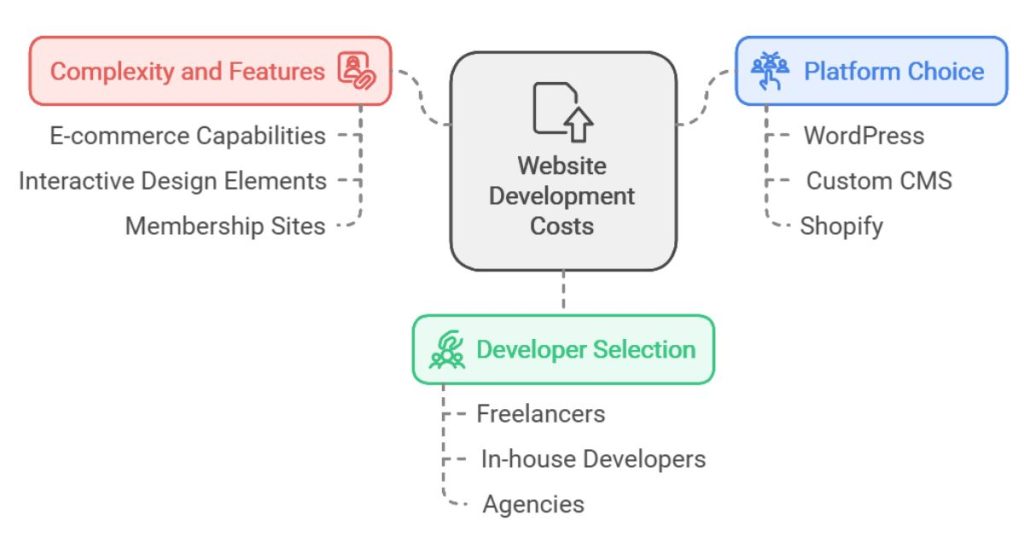
Various factors influence the cost of building a website, and understanding these helps with budget planning. Key elements include the complexity of the site, like e-commerce or membership features, and the choice between custom or template-based design.
During the website development process, additional expenses can arise from integrating third-party tools or advanced functionality like interactive elements and animations.
Developer expertise and location, whether local or offshore, also play a role in pricing. Breaking down these factors can help businesses prioritize needs and make cost-effective decisions.
1. Complexity and Features of the Website
The complexity and features of a website are major factors in determining the overall budget. Adding advanced features like e-commerce or membership options requires additional time and resources. Choosing custom web development services can allow for unique functionality, but it can also raise costs based on feature depth and interactivity.
Key cost-driving features include:
- E-commerce capabilities: Product listings, payment gateways, and order tracking add to development costs.
- Interactive design elements: Animations and dynamic content improve user experience but require extra work.
- Membership sites: Customizing user login, profile management, and exclusive content areas increases expenses.
These advanced features improve functionality and user experience but can increase costs. Balancing desired features with budget helps ensure value without overspending.
2. Platform Choice and Technical Requirements
The choice of platform plays a big role in shaping your website budget, as each option has unique costs and flexibility. Whether you choose WordPress, a custom CMS, or an e-commerce platform like Shopify, expenses will vary based on setup, customization, and ongoing fees.
For instance, building e-commerce websites on Shopify involves monthly costs, while a custom CMS provides flexibility but may require a larger upfront investment. WordPress can be budget-friendly but may need added plugins for advanced functionality. Selecting the right platform helps match your budget with your website goals effectively.
3. Developer or Agency Selection
Choosing between freelancers, in-house developers, and agencies affects your website budget and project outcomes. Freelancers are usually more affordable while hiring a web development agency provides broader expertise but at a higher cost. In-house developers offer dedicated support but come with ongoing salary expenses.
Tips to Balance Cost and Quality in Website Development
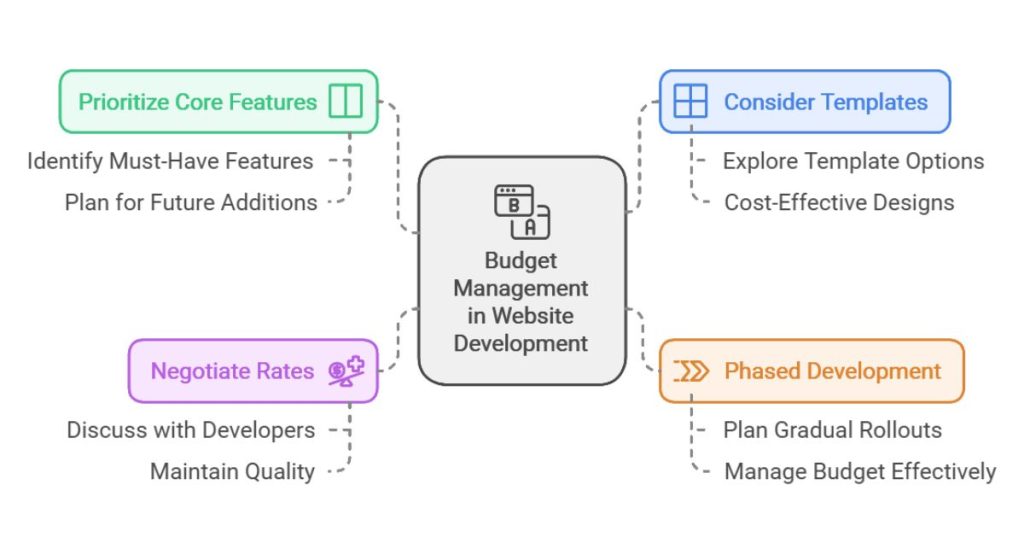
Balancing cost and quality in website development is key to getting a functional, well-designed site without overspending.
Here are a few practical tips so you can’t overrun your budget:
- Prioritize core features: Begin with must-have features and add more over time as needed.
- Consider templates: Templates offer professional layouts at a lower cost than custom designs.
- Phased development: Roll out features gradually to manage the budget better.
- Negotiate rates: Working with developers on budget-friendly solutions can help maintain quality without breaking the bank.
These strategies help ensure quality without overspending, allowing you to build a website that meets your needs while staying within budget. By focusing on essentials, using smart tools, and planning phased upgrades, you can create a strong online presence without stretching resources too thin.
Conclusion
Strategic budget planning is essential for building a quality website that aligns with your business goals and stays within budget. By focusing on core features, choosing a suitable platform, and balancing cost with quality, you set the foundation for long-term success. Effective budgeting ensures your website remains sustainable and adaptable as your business grows.
When it comes to top and website development services, Softnix is a top choice, offering expertise in cost management, quality assurance, and successful project outcomes. Our skilled team of top website developers provides you a high-quality, customized solutions that cater to each client’s unique needs.
Softnix’s commitment to client satisfaction extends beyond project completion. With dedicated support and post-launch services that keep your site secure and up-to-date, Softnix provides the ideal mix of cost efficiency and quality in website development for businesses seeking a reliable, expert partner.
Without Compromising Quality
FAQs about Plan Budget for Website Development
What factors affect website development costs the most?
Website development costs are mostly influenced by complexity, platform choice, custom features, and developer expertise. Adding advanced functions like e-commerce or interactive elements increases costs, while simpler sites remain more affordable. Developer rates and platform flexibility also impact overall expenses.
How much should I budget for a website redesign?
A website redesign typically costs anywhere from $2,000 to $15,000, depending on design complexity, required updates, and developer rates. For e-commerce or heavily customized sites, budget on the higher end. Prioritizing essential updates and user experience helps keep costs within budget.
What is the average cost of a professional website in 2024?
In 2024, the average cost of a professional website ranges from $3,000 to $30,000. Basic sites are on the lower end, while e-commerce or custom websites fall on the higher side. Costs vary based on features, design, and development needs, making budgeting essential.
How do I estimate a website development budget?
To estimate a budget, define your site’s complexity, required features, and platform. Research developer rates or agency fees and include ongoing costs like hosting and maintenance. Start with essential features and add advanced ones if the budget allows, ensuring a realistic, achievable plan.
Is it cheaper to build a website from scratch or use a template?
Using a template is generally cheaper than building from scratch. Templates save time and reduce design costs, especially for simpler sites. Custom-built websites offer more flexibility and uniqueness but often come with higher development expenses due to personalized coding and design.
What’s the cost difference between a basic website and an e-commerce site?
A basic website may cost around $2,000 to $10,000, depending on customization, while an e-commerce site typically ranges from $5,000 to $50,000 due to added features like product listings, checkout options, and payment gateways. E-commerce functionality increases both setup and maintenance costs.
How can I keep website development costs low?
To keep costs low, prioritize essential features, use a template, and consider phased development. Negotiate rates with developers and look for cost-effective plugins to enhance functionality. Planning and staying focused on primary goals can prevent costs from escalating unexpectedly.
What are the hidden costs of website development?
Hidden costs in website development often include ongoing maintenance, plugin or app fees, security updates, hosting, and scaling for higher traffic. Content updates, backups, and regular testing can also add up over time, so planning for these expenses is essential for budget control.
How much does website maintenance cost annually?
Annual website maintenance can cost between $500 and $5,000, depending on site complexity, hosting needs, and updates. Basic maintenance is cheaper, while sites with advanced features or security needs cost more. Regular maintenance keeps the site secure and running smoothly for users.
Is it worth investing in custom web design?
Investing in custom web design can be worth it for businesses needing unique features or brand-specific elements. Custom design allows for greater flexibility and a unique look but is more costly. If your goals align with custom needs, the investment can pay off in user experience.
How does the choice of CMS affect website development cost?
The CMS choice affects costs in setup, customization, and maintenance. WordPress is affordable with plugins, while a custom CMS offers flexibility but has higher initial costs. E-commerce CMS options like Shopify include fees but simplify selling. Choose based on your goals and budget.
What are the ongoing costs of running a website?
Ongoing website costs include hosting, maintenance, security updates, and content updates. Additional expenses may cover plugin fees, backups, and technical support. Annual costs vary from $500 to several thousand dollars depending on the complexity and functionality of your website.
How can I balance cost and quality in web design?
To balance cost and quality, focus on essential features and use templates or phased development to manage expenses. Prioritize user experience and scalability, and consider cost-effective plugins. Regularly review the budget to keep quality high while staying financially efficient.
Is it better to hire a freelancer, in-house developer, or agency?
Freelancers are budget-friendly for smaller projects, agencies provide broad expertise for complex sites, and in-house developers offer dedicated support but with higher long-term costs. Choose based on your project’s size, complexity, and the level of ongoing support needed.
What should be included in a website development budget?
A website development budget should include design, development, hosting, domain registration, maintenance, and ongoing costs like security updates. Consider the costs of plugins, content creation, and potential updates. A well-rounded budget ensures smooth development and long-term site performance.

